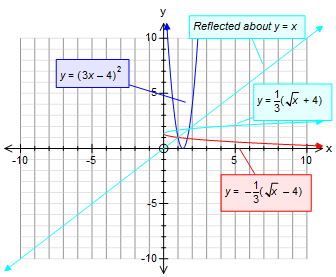What is the inverse function of #y=(3x-4)^2#?
3 Answers
Explanation:
To find the inverse function of a function, you simply switch the
You can simplify this expression:
These steps are not necessary, unless explicitly stated.
Explanation:
Given:
Square root both sides so that you only have one
Note that
'~~~~~~~~~~~~~~~~~~~~~~~~~~~~~~~~~~~~~~~
Swap the letters round
'~~~~~~~~~~~~~~~~~~~~~~~~~~~~~~~~~
Divide both sides by 3 giving:
Swap the letters round
;~~~~~~~~~~~~~~~~~~~~~~~~~~~~~~~~~~~~~~~

As this is reflected about y=x it means that, for this context, the independent variable is now y and the dependant is x. Thus ,due to the nature of the final condition it is not possible for x to become negative.
This function is not one-one so has no inverse, unless you restrict the domain.
Explanation:
Given
Take square roots of both sides to find:
#3x-4 = +-sqrt(y)#
Add
#3x = 4+-sqrt(y)#
Divide both sides by
#x=(4+-sqrt(y))/3#
This does not define a unique value of
If we restrict the domain of the original function to
#f^(-1)(y) = (4+sqrt(y))/3#
with domain



